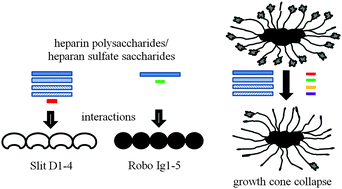Panels of chemically-modified heparin polysaccharides and natural heparan sulfate saccharides both exhibit differences in binding to Slit and Robo, as well as variation between protein binding and cellular activity†
Abstract
Heparin/heparan sulfate (HS) glycosaminoglycans are required for Slit–Robo cellular responses. Evidence exists for interactions between each combination of Slit, Robo and heparin/HS and for formation of a ternary complex. Heparin/HS are complex mixtures displaying extensive structural diversity. The relevance of this diversity has been studied to a limited extent using a few select chemically-modified heparins as models of HS diversity. Here we extend these studies by parallel screening of structurally diverse panels of eight chemically-modified heparin polysaccharides and numerous natural HS oligosaccharide chromatographic fractions for binding to both Drosophila Slit and Robo N-terminal domains and for activation of a chick retina axon response to the Slit fragment. Both the polysaccharides and oligosaccharide fractions displayed variability in binding and cellular activity that could not be attributed solely to increasing sulfation, extending evidence for the importance of structural diversity to natural HS as well as model modified heparins. They also displayed differences in their interactions with Slit compared to Robo, with Robo preferring compounds with higher sulfation. Furthermore, the patterns of cellular activity across compounds were different to those for binding to each protein, suggesting that biological outcomes are selectively determined in a subtle manner that does not simply reflect the sum of the separate interactions of heparin/HS with Slit and Robo.


 Please wait while we load your content...
Please wait while we load your content...